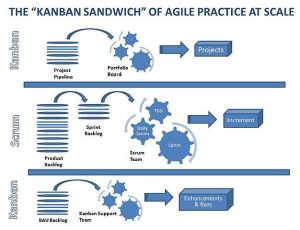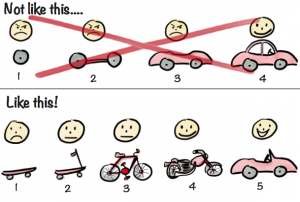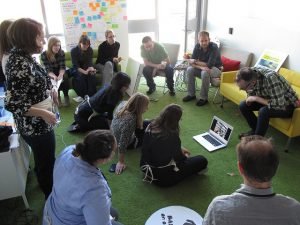Lean Product Development (or Design), LPD, is gradually becoming a standard methodology in software development in much the same way that agile, scrum and lean have become industry standards. But, as is the case with other «standards» – many people say they have strong implementations, but if your product development team practices LPD principles, you might have trouble trying to integrate their approach. That problem can be troubling if you’ve invested in a rigorous, repeatable process for developing and releasing new software products and then find it difficult to find outsourcing services who understand your goals, your process and can work alongside your team seamlessly.
If you have software applications as a part of your services portfolio or directly to clients and use LPD methodologies, it is important to fully integrate your development team. But, if you are using an outsourcing service, what should you expect? How important is it to integrate your outsourced team?
A Little Level-Setting
In strict thinking, although the term «LPD» is used interchangeably for design and development, there are some differences in focus between the two in implementation. Both are based on Lean, the principles that started with Toyota Manufacturing and have evolved to embrace a process of finding solutions to customer problems that emphasizes iteration, reducing waste, and lowering risk. Broadly, both are informed by the Lean Startup Methodology, but because LPD has been adopted by many large organizations for the development of service and product lines, lessons from Lean Startup are brought down to the product level, rather than at a business model level as they are for startups. And, because we are specifically interested in services, software and software development, rather than manufacturing and the development of physical products, we can include the fact that all LPD implementations favor the use of agile, scrum and kanban as development methodologies.

As you might guess from the use of the word design, Lean Product Design implementations are focused on the design of the product, the user interface (UI) in software development terms and how the user interacts with the application. A process flow for a design implementation includes a growing system of sketches of screens (or modules), wireframes and design standards that evolve and become more specific as software development progresses through iterations.
Lean Product Development implementations tend to focus on the features required to satisfy user needs and product goals. So, while both implementations will use agile user story techniques, design-based implementations will be placed more in the context of the UI and user experience. Development implementations will focus more on groups of features and user goals. In practice, the differences between the two are relatively small and depend more on the full project team and their process than anything. A development team with clients that tend to be more visual, literal and unsure of needs may find it easier to be design-focused. A team with clients working on a business process and users with strong, informed opinions may find it easier to be more development-focused. And certainly, there are many blends of the two ways of thinking.
So, What Does This Mean?
There are many software applications that embody process and principles from a software product management point of view. How will they work for you if you decide to use an outsourced software development partner to help bring your application to market? Is one or the other better for software applications or integrating with software development teams? Are there methodologies or points to emphasize with potential partners as you discuss how their product development approach and experience?
From a high level, if your potential vendor has good product development experience and understands the product development cycle fully, the software you use for product management and the implementation of agile they use within their software development process shouldn’t matter a great deal – because they should be able to be flexible and do what is necessary to integrate the teams. If they are using something out of a book or a seminar that they have actually practiced a few times with a client – and that client wasn’t themselves fully committed to formal product management – it will be a distracting challenge for both teams to work through a methodology implementation while developing your application.
5 Questions for Your Potential Partner
Let’s start with a few questions to discuss. And a word about interviews: Don’t ask yes or no questions when you are investigating how a vendor operates and works with clients. Instead, ask open-ended questions that should be answered with more than a few words (if they actually have experience and formal services around the area they are discussing). If you don’t get what you feel is a strong answer, again, ask some open-ended questions that go down a level in detail.
1. Tell me about how you use agile in projects with clients practicing Lean Product Development?
The question here is not «do you use agile?» You need to know how agile informs their work with companies practicing LPD and what value they believe their implementation brings their customers. They should also include their practices within agile, such as scrum, extreme programming (XP), or kanban. If they don’t go into this level, ask another open-ended question for more detail.

One of the many implementations that large organizations have used.
In most cases, scrum will be the task management and basic development guideline, but it may be extended by XP practices. Some teams will be familiar with kanban and some will mention that they might start with scrum and transition to kanban if the project uses a DevOps implementation aimed at continuous development. At a high-level, the choice between scrum and kanban comes down to a philosophy about work and how to manage tasks. Scrum is generally considered to be more structured, using time-boxed iterations (sprints) and depending on the team to properly estimate tasks for each sprint and with specific planning and retrospective sessions for managing task backlog and priorities. Kanban tends to limit the number of tasks a team can have in work at the same time and new tasks are pulled down into development as soon as a slot opens up in the queue. Kanban is generally more flexible for the insertion of new features and less structured, requiring more feature management to avoid creep before the base application is completed.
It is only a guideline, but most teams find scrum to be a good system in application development and might use kanban or a variation after full release when the application is in maintenance or continuous development. Again, team familiarity and experience in adjusting their «standard» implementation to your team is more important than the particular flavor of the methodology they are using. Process mockups and walkthroughs of feature and feedback flow between the teams is an excellent way to evaluate how things might work and adjust to situations.
2. How do you understand the MVP process in lean product development?

Iterative development of a minimum viable product (MVP) is critical in LPD and probably one of the least understood parts of the cycle by non-practitioners. It is also very hard to estimate effort and time for the development team because it involves an open-ended process with key stakeholders and users. The key issue is to understand what they expect and how they will help you towards viable iterations for validation.
If their understanding is more like the top example in this illustration than the second, it is going to require some real thought to ensure you arrive at validation releases that are fully-formed (loveable) but not feature-rich or too simplistic. This is an element of your work as a whole team where you can really assess the ability of your outsourced team to work fully as a partner in product development. Can they come up with creative ways to give a good representation of the core product to users with less effort and time? Can they see the evolution of ideas and pick out key elements in customer feedback? If you expect or have to micro-manage every iteration yourself, you’re not getting a fully-prepared software development team.
3. How will we capture and manage user feedback during validation and following initial release?
 Now, of course – a developer could just say, «This is your problem, not mine.» To a degree, they would be right, but you are looking for partner-level answers that indicate a willingness to do whatever is needed to make the product development process work properly and to be in position for the long run if your product is likely to benefit from a continuous development/improvement, DevOps-type release. Possible answers can be all over the board from add-on services that support help desk and application feedback to in-app custom modules. At a minimum, developers should be «in the loop» during validation and early release to assure that application bugs are not being reported as feature requests or issues and a system should be available to allow users to see proposed changes and «vote up or down» features they would value.
Now, of course – a developer could just say, «This is your problem, not mine.» To a degree, they would be right, but you are looking for partner-level answers that indicate a willingness to do whatever is needed to make the product development process work properly and to be in position for the long run if your product is likely to benefit from a continuous development/improvement, DevOps-type release. Possible answers can be all over the board from add-on services that support help desk and application feedback to in-app custom modules. At a minimum, developers should be «in the loop» during validation and early release to assure that application bugs are not being reported as feature requests or issues and a system should be available to allow users to see proposed changes and «vote up or down» features they would value.
Including the development team in the feedback loop has a cost, but it avoids a lot of thrash when a feature is not working as expected, allows the developers to be proactive with corrective actions and to understand needs directly from a user’s words, rather than summaries. Again, what you are looking for is not a specific answer but that your partner is willing and able to understand what you need from a product perspective and provide creative solutions.
4. What are our options for capturing user metrics?
This requirement is, of course, very similar to capturing user feedback, so solutions can range from custom reporting within the application to third-party services and application libraries. In this case, the richness of options is key so you can evaluate different aspects of customer acquisition, feature usage, time to complete a process, etc. These features don’t exist in «average» applications, but they can be added relatively easily during development, especially if you compare the effort required to add them at some later point. You will have to get into detail about the kinds of metrics you feel might be most useful for your application and situation, but a strong developer team should be able to give you a range of options for implementation and some sort of dashboard for generating reports.
5. What do you do to assure that quality issues don’t get in the way?
It may seem a bit off point to discuss quality in an LPD focused question set, but the quality is far and away one of the biggest issues when it comes to unexpected project delays. You can’t expect stakeholders and users to be fully engaged in the product development process if planned releases are delayed or major features don’t appear fully formed as promised. A really good application that is unstable or has a poorly designed user interface is a big distraction from the goals of LPD project.
 The best answers to this question include test-driven development, test automation, continuous integration and the tools that could eventually come into play if you choose to go into continuous development. The best case is to make this decision upfront, but things don’t always work out that way. Your primary aim should be to ensure you are in a position to move to that level when you need to without backtracking or having less than full test coverage and to leverage quality assurance tools and processes proactively from the beginning. Your team should be able to focus on feature execution and user experience as they do their acceptance and not buggy code or user interface inconsistencies.
The best answers to this question include test-driven development, test automation, continuous integration and the tools that could eventually come into play if you choose to go into continuous development. The best case is to make this decision upfront, but things don’t always work out that way. Your primary aim should be to ensure you are in a position to move to that level when you need to without backtracking or having less than full test coverage and to leverage quality assurance tools and processes proactively from the beginning. Your team should be able to focus on feature execution and user experience as they do their acceptance and not buggy code or user interface inconsistencies.
The answers to this question should cover many of the issues of how teams will work and communicate. If they don’t, push follow-up questions in that direction specifically. If you have read anything about outsourcing, you already know that successful agile teams require strong open dialog and collaboration. Don’t let easy answers push you off this point. Understand fully how your project will deal with quality, communication, and ownership of the project goals.
 There are a lot more questions you could ask, but these should get you started. The point is to have a conversation with your prospective vendor and come to an understanding of the methodologies they have utilized, the capabilities they bring to the table, and the customer experience you can expect. A conversation can clear up a lot more issues than a written response to an RFI or a proposal for work and give you a better idea if this is a group you can see your team working with. If you are actually looking for a long term partner and not just a team for a short engagement, it would be wise to have that conversation in person – in your offices or theirs. If it requires some travel, it is just part of the expense of finding a good match. It is much better to have your first face-to-face meetings in a positive, forward-looking atmosphere than when a project is underway and you’ve realized that a lot needs to be done to iron out issues.
There are a lot more questions you could ask, but these should get you started. The point is to have a conversation with your prospective vendor and come to an understanding of the methodologies they have utilized, the capabilities they bring to the table, and the customer experience you can expect. A conversation can clear up a lot more issues than a written response to an RFI or a proposal for work and give you a better idea if this is a group you can see your team working with. If you are actually looking for a long term partner and not just a team for a short engagement, it would be wise to have that conversation in person – in your offices or theirs. If it requires some travel, it is just part of the expense of finding a good match. It is much better to have your first face-to-face meetings in a positive, forward-looking atmosphere than when a project is underway and you’ve realized that a lot needs to be done to iron out issues.
Scio is a vendor of outsourced, nearshore software development services to our clients in North America. We provide teams with a background in Lean Product Development as a part of our service portfolio. We use agile methodologies and adapt them to the situation and needs of our clients. If you are interested in how we could partner with your organization to build a great set of new products – Contact Us. We would be glad to take the time to discuss your needs.
